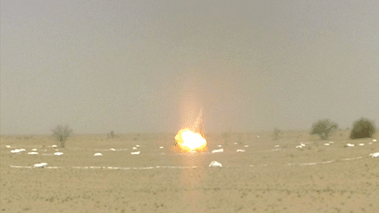New Delhi: India Friday successfully test fired an indigenously-made 500-kg class “inertial guided bomb” from a Sukhoi jet at the Pokhran test range in Rajasthan. The test has been pegged as a major achievement for the Defence Research and Development Organisation (DRDO) as the guided bomb achieved the desired range and also hit its target with precision.
“All the mission objectives have been met. The weapon system is capable of carrying different warheads,” a statement from the Ministry of Defence said.
Sources in the defence establishment said that the inertial guided bomb marks an upgrade from the existing laser-guided weapon delivery capability, which has certain limitations, such as range of delivery from the target and susceptibility to environmental conditions.
“It is also a testament to DRDO’s capability to develop miniaturised inertial navigation systems that can function under tough conditions,” a source told ThePrint.
ThePrint explains the upgrade in weapon technology and its implications for the country’s defence capability.
What is this bomb?
This 500-kg class precision bomb is guided to its target through the inertial guidance system, which allows precision targeting from long distances even under adverse visibility conditions.
According to Britannica, the inertial guidance system is an electronic system that continuously monitors the position, velocity and acceleration of a vehicle, usually a submarine, missile, or aeroplane, and provides navigational data or control without the need for communicating with a base station.
When an inertial navigation system is installed in a bomb, the system can help navigate the bomb to its designated target by continuously providing updated navigation inputs. Such systems have the unique ability to perform without depending on external inputs such as ground-based navigation aids as well as GPS, defence experts told ThePrint
A recent example of such a bomb is the Israeli SPICE-2000 smart bombs that were used by the Indian Air Force in the Balakot attack in Pakistan. They had a glide range of around 60 km and used a sophisticated guided system — including inertial navigation, satellite guidance and electro-optical sensors, for accuracy.
Countries such as the United States and Israel have been using such guided bombs for some years, but it is a first for India, with the system being indigenously developed by the DRDO.
A senior IAF official explained that navigation has mainly two aspects. “Where you are at the moment and what is your destination are the two aspects of navigation,” the official said. “The weapon’s current location is dictated by the aircraft’s inertial navigation system. The destination is guided by feeding it with target coordinates and the desired weapon path is achieved by other control inputs,” the official added.
“Such a bomb does not have an engine of its own but runs on the inertia imparted to it by the mother aircraft.”
A retired IAF official, who did not wish to be identified, said: “Such a weapon can be fired even without a Global Navigation Satellite System (GNSS) input, denial of which is a high possibility in emerging forms of warfare.”
Indian fighter jets had inertial navigation systems earlier too, but the weapons were based on optical or laser guidance. However, this bomb uses a miniaturised Inertial Navigation Systems — indigenously developed by DRDO — as an integral component.
Also read: Indian Army deploys US-, Italy-trained snipers with deadly new rifles along LoC
How does it boost country’s defence capability?
Defence sources said the new capability, when operationally deployed, would allow an IAF aircraft to deliver weapons from longer ranges, thus allowing them to stay away from enemy air defence cover. “This would ensure higher battlefield survivability of the aircraft and ensure the safety of the pilots and the delivery platforms,” the sources said.
It would also ensure high mission reliability and low collateral damage, which could be an effective strategic deterrence for an adversary, the sources added. This inertial guidance technology will also be useful for the development of other long-range precision-guided weapons.
While the DRDO is developing these high accuracy weapon delivery systems, capable of working on GNSS degraded and denied environments, getting accurate target coordinates is still a challenge.
A strong focus would also be required to ensure that accurate target coordinates are available to the user to ensure high mission reliability.
Also read: Satellite imagery reveals Chinese navy’s war games for a possible attack on Taiwan




Pakistan already used them on Feb 27 when they launched multiple H4 strikes in Indian Occupied Kashmir.
It is a joke of jawans. Jawan can purchase only car upto 5 lakhs. It is a disgrace for jcos and jawans. And what about modiji statement. I will strong our armed fources . But this discussion is demoralizing Jawan and JCO . Previous discussion is better than this discussion. Any car up to 1600 cc of any cost is purchase by Jawan.
Kindly change the discussion and applying previous discussion……..
How are these air based rockets different than land based rockets. The land based rockets can also do the same job of destroying surface or air or sea based targets.
Finally, just like a curry the ingredients of India’s military are so varied. Its simply not possible to make sense.
But the fact is pak has a stronger air force and thats a shame.